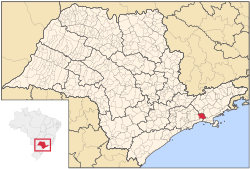|
Salesópolis
Salesópolis is a municipality in the state of São Paulo in Brazil. It is part of the Metropolitan Region of São Paulo.[3] The population is 17,252 (2020 est.) in an area of 424.997 km².[4] Salesópolis sits at an elevation of 850 metres (2,790 ft). It is noted for being the source of the Tietê River.[5] Salesópolis was founded in the 19th century as São José do Paraitinga, and later became the parish of Santana de Mogi das Cruzes in 1838. The parish was elevated to municipality status on March 24, 1857, but renamed Salesópolis in 1905 after a visit of the president of Brazil, Campos Sales (1841-1913).[5] The Tietê River flows in the northern part of the municipality, and much of the southern part of the municipality is mountainous, heavily forested, and inaccessible. The Atlantic Forest (Mata Atlântica) of Salesópolis were largely destroyed in the late 19th and early 20th century, but 96 ha of the municipality are now protected as part of the Boracéia Biological Station, a unit of the Museum of Zoology of the University of São Paulo established in 1954. Salesópolis is home to the Buchenavia rabelloana, a species of plant in the Combretaceae family. The species is listed as endangered on the IUCN Red List of Threatened Species.[6][7] Population history
MediaIn telecommunications, the city was served by Companhia de Telecomunicações do Estado de São Paulo until 1975, when it began to be served by Telecomunicações de São Paulo.[8] In July 1998, this company was acquired by Telefónica, which adopted the Vivo brand in 2012.[9] The company is currently an operator of cell phones, fixed lines, internet (fiber optics/4G) and television (satellite and cable).[9] See alsoReferences
External links
|
||||||||||||||||||||||||||||||||||||||||||||||||||||








